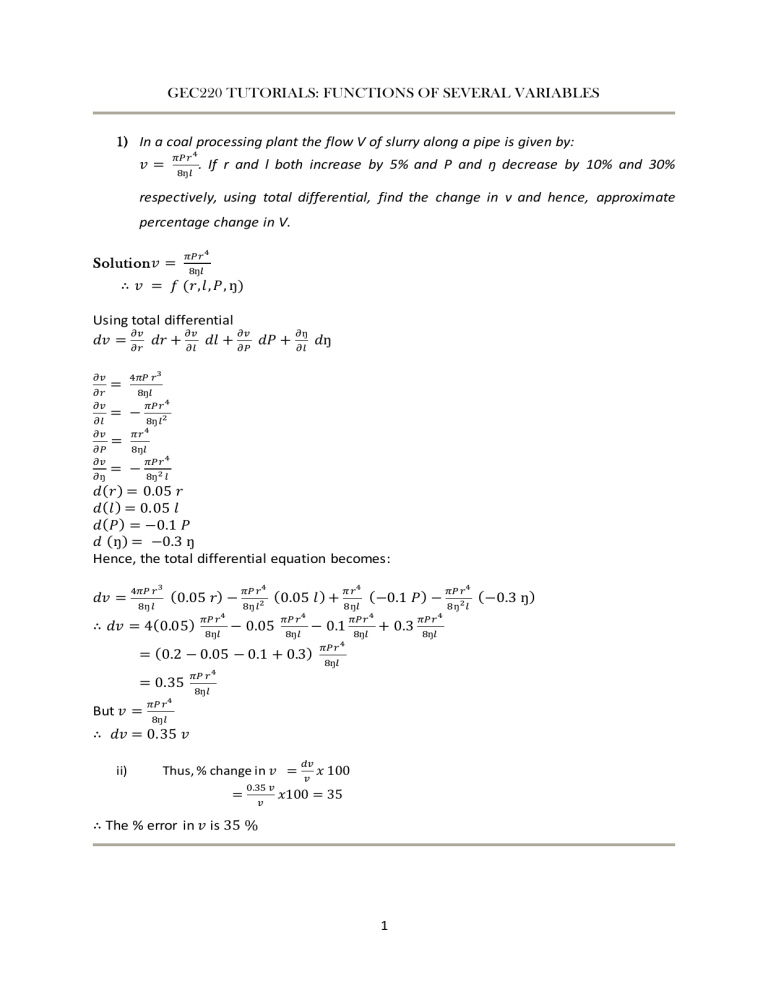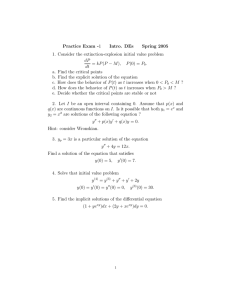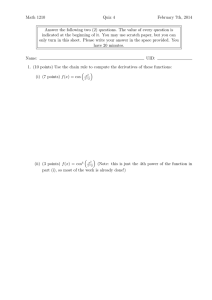GEC220 TUTORIALS FUNCTIONS OF SEVERAL VARIABLES
advertisement

GEC220 TUTORIALS: FUNCTIONS OF SEVERAL VARIABLES 1) In a coal processing plant the flow V of slurry along a pipe is given by: 𝑣= 𝜋𝑃𝑟4 8ŋ𝑙 . If r and l both increase by 5% and P and ŋ decrease by 10% and 30% respectively, using total differential, find the change in v and hence, approximate percentage change in V. Solution𝑣 = 𝜋𝑃𝑟4 8ŋ𝑙 ∴ 𝑣 = 𝑓 (𝑟, 𝑙, 𝑃, ŋ) Using total differential 𝜕𝑣 𝜕𝑣 𝜕𝑣 𝜕ŋ 𝑑𝑣 = 𝜕𝑟 𝑑𝑟 + 𝜕𝑙 𝑑𝑙 + 𝜕𝑃 𝑑𝑃 + 𝜕𝑙 𝑑ŋ 𝜕𝑣 𝜕𝑟 𝜕𝑣 𝜕𝑙 𝜕𝑣 𝜕𝑃 𝜕𝑣 𝜕ŋ = 4𝜋𝑃 𝑟3 8ŋ𝑙 𝜋𝑃𝑟4 = − = 8ŋ𝑙2 𝜋𝑟4 8ŋ𝑙 𝜋𝑃𝑟4 = − 8ŋ2 𝑙 𝑑 (𝑟) = 0.05 𝑟 𝑑 (𝑙 ) = 0.05 𝑙 𝑑 (𝑃) = −0.1 𝑃 𝑑 (ŋ) = −0.3 ŋ Hence, the total differential equation becomes: 𝑑𝑣 = 4𝜋𝑃 𝑟3 8ŋ𝑙 4 4 8ŋ𝑙 ∴ 𝑑𝑣 = 4(0.05) 𝜋𝑃𝑟4 8ŋ𝑙 − 0.05 𝜋𝑃𝑟4 8ŋ𝑙 = 0.35 8ŋ𝑙 𝜋𝑃𝑟4 − 0.1 = (0.2 − 0.05 − 0.1 + 0.3) But 𝑣 = 4 (0.05 𝑟) − 𝜋𝑃𝑟2 (0.05 𝑙 ) + 𝜋𝑟 (−0.1 𝑃) − 𝜋𝑃𝑟2 (−0.3 ŋ) 8ŋ𝑙 8ŋ 𝑙 + 0.3 𝜋𝑃𝑟4 8ŋ𝑙 𝜋𝑃 𝑟4 8ŋ𝑙 𝜋𝑃𝑟4 8ŋ𝑙 ∴ 𝑑𝑣 = 0.35 𝑣 ii) Thus, % change in 𝑣 = = 0.35 𝑣 𝑣 𝑑𝑣 𝑣 𝑥 100 𝑥100 = 35 ∴ The % error in 𝑣 is 35 % 1 𝜋𝑃𝑟4 8ŋ𝑙 2) The rate of flow of gas in a pipe, 𝑣 is given by: 𝑣 = 𝐶 𝑑 1 ⁄2 𝑇 −5 ⁄6 where 𝐶 is a constant, 𝑑 is the diameter of the pipe and 𝑇 is the thermodynamic temperature of the gas. When determining the rate of flow experimentally, 𝑑 is measured and subsequently found to be in error by +1.4% of 𝑑, and 𝑇 has an error of –1.8% of 𝑇. (i) Using total differential, determine the error (change) in the rate of flow, 𝑣, based on the measured values. Leave your answer in terms of 𝑣. (ii) Hence, determine the percentage error in the rate of flow. Solution 𝑣 = 𝐶 𝑑 1 ⁄2 𝑇 −5 ⁄6 𝐶 = 𝐶𝑜𝑛𝑠𝑡𝑎𝑛𝑡 ∴ 𝑣 = 𝑓 (𝑑, 𝑇) Using total differential 𝜕𝑣 𝜕𝑣 𝑑𝑣 = 𝜕𝑑 𝑑(𝑑 ) + 𝜕𝑇 𝑑𝑇 𝜕𝑣 𝜕𝑑 𝜕𝑣 1 = 𝐶 (2 𝑑 −1⁄2 ) (𝑇 −5 ⁄6 ) 5 = 𝐶 (𝑑 1 ⁄2 ) (− 6 𝑇 −11 ⁄6 ) 𝑑 (𝑑 ) = 0.014 𝑑 𝑑 (𝑇 ) = −0.018 𝑇 Hence, the total differential equation becomes: 𝜕𝑇 1 5 𝑑𝑣 = 𝐶 (2 𝑑 −1 ⁄2 ) (𝑇 −5 ⁄6 ) (0.014 𝑑 ) + 𝐶 (𝑑 1 ⁄2 ) (− 6 𝑇 −11 ⁄6 ) (−0.018 𝑇) ∴ 𝑑𝑣 = 0.007 𝐶 (𝑑 1 ⁄2 ) (𝑇 −5 ⁄6 ) + 0.015 𝐶 (𝑑 1 ⁄2 ) (𝑇−5 ⁄6 ) = 0.022 𝐶 (𝑑 1 ⁄2 ) (𝑇 −5 ⁄6 ) But 𝑣 = 𝐶 𝑑 1 ⁄2 𝑇 −5 ⁄6 ∴ 𝑑𝑣 = 0.022 𝑣 iii) Thus, % change in 𝑣 = = 0.022 𝑣 𝑣 𝑑𝑣 𝑣 𝑥 100 100 = 2.2 ∴ The % error in 𝑣 is 2.2 % 3) In a right-angled triangle, 𝐜 denotes the hypotenuse, while 𝐚 and 𝐛 represent its other two sides. If 𝐜 is increasing at the rate of 2 cm/s while 𝐚 is decreasing at the rate of 3 cm/s. Using chain rule, calculate the rate at which 𝐛 is changing when 𝐜 = 5 cm and 𝐚 = 3 cm. Hint: use Pythagoras theorem to relate 𝐛 to 𝐚 and 𝐜. SOLUTION From Pythagoras theorem, 𝑐 2 = 𝑎2 + 𝑏2 2 1 ∴ 𝑏 = (𝑐 2 − 𝑎 2 ) 2 𝑏 = 𝑓 (𝑐, 𝑎) (𝑐, 𝑎 ) = 𝑓 (𝑡) 𝜕𝑏 𝜕𝑡 =? Using chain rule 𝜕𝑏 𝜕𝑏 = 𝜕𝑡 𝜕𝑏 . 𝜕𝑐 𝜕𝑐 𝜕𝑡 1 = (𝑐 2 − 𝜕𝑐 2 + 𝑎 𝜕𝑏 𝜕𝑎 1 2 )−2 . 𝜕𝑎 𝜕𝑡 ∙ 2𝑐 1 = 𝑐 ∙ (𝑐 2 − 𝑎2 )−2 𝑐 = 2 2 √𝑐 −𝑎 𝜕𝑏 𝜕𝑎 1 1 = (𝑐 2 − 𝑎2 )−2 ∙ (−2𝑎) 2 1 = −𝑎 ∙ (𝑐 2 − 𝑎2 )−2 −𝑎 = 2 2 √𝑐 −𝑎 𝑑𝑐 = 2 𝑐𝑚/𝑠 𝑑𝑡 𝑑𝑎 𝑑𝑡 = −3 𝑐𝑚/𝑠 𝑐 = 5𝑐𝑚 𝑎 = 3 𝑐𝑚 𝜕𝑏 𝜕𝑡 𝑐 = √𝑐 2 −𝑎2 . (2 ) + −𝑎 √𝑐 2 −𝑎2 . (−3) When 𝑐 = 5𝑐𝑚 and 𝑎 = 3 𝑐𝑚 𝜕𝑏 𝜕𝑡 = 5 √5 2 −3 2 = = 10 4 19 4 . (2 ) + + −3 √5 2 −3 2 . (−3) 9 4 𝑐𝑚 = 4.75 𝑐𝑚 𝑏 is increasing at the rate of 4.75 𝑐𝑚/𝑠 4) Using chain rule, find the rate of change of the total surface area, 𝑆,of a right circular cone at the instant when thebase radius, 𝑟, is 5cmand the height, ℎ, is 12cmif theradius is increasing at 0.5cm/s and the heightis decreasing at 1.5 cm/s. Given that 𝑆 = 𝜋 𝑟2 + 𝜋𝑟 √(𝑟2 + ℎ2 ). SOLUTION S= 𝜋𝑟2 + 𝜋r √(𝑟2 + ℎ2 ) =𝜋 𝑟2 + 𝜋𝑟(𝑟2 + ℎ2 )1/2 𝑆 = 𝑓 (𝑟, ℎ) 3 (𝑟, ℎ ) = 𝑓 (𝑡) 𝜕𝑠 𝜕𝑡 =? Using chain rule 𝜕𝑠 𝜕𝑠 = 𝜕𝑡 𝜕𝑟 𝜕𝑟 𝜕𝑠 . 𝜕𝑡 + 𝜕ℎ . 𝜕𝑡 𝜕ℎ 1 𝑑 ((𝑟2 +ℎ2 )2 ) 𝜕𝑠 = 2𝜋𝑟 + 𝜋𝑟 ∙ 𝜕𝑟 𝑑𝑟 1 =2𝜋𝑟 + 𝜋𝑟. (𝑟2 + ℎ 2 𝜋𝑟2 + (𝑟2 +ℎ2 )1/2 =2𝜋𝑟 𝜕𝑠 1 + ( 𝑟 2 + ℎ2 ) 2 . 1 2 ) −2 𝑑 ( 𝜋𝑟) 𝑑𝑟 ∙ 2𝑟 + (𝑟2 + ℎ2 )1/2. . 𝜋 + 𝜋 (𝑟2 + ℎ2 )1/2 1 = 𝜋𝑟. 2 ( 𝑟2 + ℎ2 )−1/2 . 2ℎ 𝜕ℎ 1 = 𝜋𝑟ℎ ∙ (𝑟2 + ℎ2 )−2 Given: 𝑑𝑟 = 0.5 𝑐𝑚/𝑠 𝑑𝑡 𝑑ℎ 𝑑𝑡 = −1.5 𝑐𝑚/𝑠 𝑟 = 5𝑐𝑚 ℎ = 12𝑐𝑚 1 (𝑟2 + ℎ2 )2 = (52 + 122 )1/2 = √(25 + 144) = √169 = 13 𝜕𝑠 𝜕𝑟 ( )2 𝜋 5 = 2𝜋(5) + 13 + 𝜋 (13) 25 =10 𝜋 + 13 𝜋 + 13𝜋 130𝜋+25𝜋+169𝜋 = 𝜕𝑠 = 𝜕ℎ 𝜕𝑠 𝜕𝑡 13 𝜋 (( 5) ( 12) ) 13 = 324 13 = = 60 13 = 324𝜋 13 𝜋 60 𝜋. (0.5) + 13 𝜋. (−1.5) 162 13 72 𝜋− 90 13 𝜋 =13 𝜋 = 17.4 𝑐𝑚/𝑠 −1 5) Given that 𝒙𝟐 + 𝒚𝟐 − 𝒛𝟐 + 𝒙𝒛 − 𝒚𝒛 = 𝟏 using the general implicit formula, find 𝜕𝑧 𝜕𝑥 𝑎𝑛𝑑 𝜕𝑧 𝜕𝑦 SOLUTION 𝒙𝟐 + 𝒚𝟐 − 𝒛𝟐 + 𝒙𝒛 − 𝒚𝒛 − 𝟏 = 𝟎 4 𝜕𝑧 = − 𝜕𝑥 𝜕𝑧 𝜕𝑦 = − 𝐹𝑥 𝐹𝑧 𝐹𝑦 𝐹𝑧 𝐹𝑥 = 2𝑥 + 𝑧 𝐹𝑦 = 2𝑦 − 𝑧 𝐹𝑧 = −2𝑧 + 𝑥 − 𝑦 ∴ 𝜕𝑧 𝜕𝑥 = − =( 2𝑥+𝑧 −2𝑧+𝑥 −𝑦 2𝑥 +𝑧 2𝑧−𝑥 +𝑦) 𝜕𝑧 2𝑦 − 𝑧 = − 𝜕𝑦 −2𝑧 + 𝑥 − 𝑦 =( 2𝑦−𝑧 2𝑧−𝑥 +𝑦) 6) Given that 𝑒 𝑢 𝑠𝑖𝑛 𝑉 = 𝑦, using the general implicit formula, find SOLUTION: 𝑒 𝑢 𝑠𝑖𝑛 𝑉 = 𝑦, ∴ 𝑒 𝑢 𝑠𝑖𝑛 𝑉 − 𝑦 = 0 Using general implicit formula, 𝜕𝑢 𝜕𝑦 𝜕𝑢 𝜕𝑣 𝜕𝑣 𝜕𝑦 𝐹𝑦 = − 𝐹𝑢 𝐹𝑣 = − = − 𝐹𝑢 𝐹𝑦 𝐹𝑣 𝐹𝑢 = 𝑒 𝑢 𝑠𝑖𝑛 𝑉 𝐹𝑦 = −1 𝐹𝑣 = 𝑒 𝑢 𝑐𝑜𝑠 𝑉 ∴ 𝜕𝑢 𝜕𝑦 = − = (−1 ) 𝑒𝑢 𝑠𝑖𝑛 𝑉 1 𝑒𝑢 𝑠𝑖𝑛 𝑉 5 𝜕𝑢 𝜕𝑦 𝜕𝑢 , 𝜕𝑣 𝑎𝑛𝑑 𝜕𝑣 𝜕𝑦 𝜕𝑢 𝑒 𝑢 𝑐𝑜𝑠 𝑉 𝑐𝑜𝑠 𝑉 = − 𝑢 =− 𝜕𝑣 𝑒 𝑠𝑖𝑛 𝑉 𝑠𝑖𝑛 𝑉 =− 𝜕𝑣 𝜕𝑦 1 𝑡𝑎𝑛 𝑉 (−1 ) =− 𝑒 𝑢 𝑐𝑜𝑠 𝑉 1 = 𝑒𝑢 𝑠𝑖𝑛 𝑉 7) Using general implicit formula, find 𝜕𝑧 𝜕𝑥 and 𝜕𝑧 𝜕𝑦 for the function: 𝑥 3 𝑧 2 − 5𝑥𝑦 5 𝑧 = 𝑥 2 + 𝑦 3 3 2 5 2 𝑥 3 𝑧 2 − 5𝑥𝑦 5 𝑧 = 𝑥 2 + 𝑦 3 3 𝑥 𝑧 − 5𝑥𝑦 𝑧 − 𝑥 − 𝑦 = 0 Using general implicit formula, 𝜕𝑧 𝑓 = − 𝑓𝑥 𝜕𝑥 𝑧 𝑓 𝜕𝑧 = − 𝑓𝑦 𝜕𝑦 𝑧 𝑓𝑥 = 3𝑥 2 𝑧 2 − 5𝑦 5 𝑧 − 2𝑥 𝑓𝑦 = −25𝑥𝑦 4 𝑧 − 3𝑦 2 𝑓𝑧 = 2𝑥 3 𝑧 − 5𝑥𝑦 5 ∴ 𝜕𝑧 𝜕𝑥 𝜕𝑧 𝜕𝑦 =− = − 𝑓𝑥 𝑓𝑧 𝑓𝑦 𝑓𝑧 = − = (3𝑥2 𝑧2 −5𝑦5 𝑧−2𝑥) 2𝑥3 𝑧−5𝑥𝑦5 25𝑥𝑦4 𝑧+3𝑦2 2𝑥3 𝑧−5𝑥𝑦5 ( −𝛼 ) 8) A possible equation of state for a gas takes the form: 𝑃𝑉 = 𝑅𝑇 𝑒 𝑉𝑅𝑇 in which 𝛼 and R 𝜕𝑃 𝜕𝑉 are constants. Using the general implicit formula, determine expressions for , 𝑎𝑛𝑑 𝜕𝑉 𝜕𝑇 𝜕𝑇 𝜕𝑃 SOLUTION 𝑃𝑉 = 𝑅𝑇 𝑒 −𝛼 ) 𝑉𝑅𝑇 ( 6 ∴ 𝑃𝑉 − 𝑅𝑇 𝑒 −𝛼 ) 𝑉𝑅𝑇 ( =0 Using the general implicit formula, 𝜕𝑃 𝜕𝑉 𝜕𝑉 𝜕𝑇 𝜕𝑇 𝜕𝑃 = − 𝐹𝑉 = − 𝐹𝑇 = − 𝐹𝑃 𝐹𝑃 𝐹𝑉 𝐹𝑇 𝜕 [𝑃𝑉 − 𝑅𝑇 𝑒 𝐹𝑃 = −𝛼 ( ) 𝑉𝑅𝑇 ] 𝜕𝑃 = 𝑉 𝜕 [𝑃𝑉 − 𝑅𝑇 𝑒 𝐹𝑉 = 𝜕𝑉 𝜕[𝑒 = 𝑃 − 𝑅𝑇 =𝑃− 𝛼 𝑉 [( −𝛼 ) 𝑉 −1 ] 𝑅𝑇 ] 𝜕𝑉 𝛼 = 𝑃 − 𝑅𝑇 [ 𝑒 2 𝑉 2 𝑅𝑇 ( 𝐹𝑇 = 𝑒 ( −𝛼 ) 𝑉𝑅𝑇 ] −𝛼 ) 𝑉𝑅𝑇 𝜕 [𝑃𝑉 − 𝑅𝑇 𝑒 = −𝛼 ( ) 𝑉𝑅𝑇 ] −𝛼 ( ) 𝑉𝑅𝑇 ] 𝜕𝑇 𝜕 (𝑃𝑉 ) 𝜕𝑇 ( −𝛼 ) − 𝜕 [−𝑅𝑇 𝑒 𝑉𝑅𝑇 ] 𝜕𝑇 Using product rule to differentiate the R.H.S: [ ( −𝛼) 𝑇 −1] ] 𝜕 [ 𝑒 𝑉𝑅 = 0 − [𝑅𝑇 = − [𝑅𝑇 ∙ = −𝑅 ∙ 𝑒 ∴ 𝜕𝑇 𝛼 𝑉𝑅 𝑇 ( 𝑒 2 −𝛼 ) 𝑉𝑅𝑇 [ −𝛼 ) 𝑉𝑅𝑇 ( 𝛼 𝑉𝑅𝑇 + 𝑒 −𝛼 ) 𝜕 [ 𝑅𝑇] 𝑉𝑅𝑇 ( +𝑅∙𝑒 𝜕𝑇 ( −𝛼 ) 𝑉𝑅𝑇 ] + 1] 𝝏𝑷 𝑭 = − 𝑽 𝝏𝑽 𝑭𝑷 ( −𝜶 ) = − 𝜶 𝑷− 𝟐 𝒆 𝑽𝑹𝑻 𝑽 𝑽 7 ] 𝜕𝑉 𝐹𝑇 = − =− 𝜕𝑇 𝐹𝑉 = −𝑅 ∙ 𝑒 −𝛼 ( ) 𝑉𝑅𝑇 𝑃− [ 𝛼 + 1] 𝑉𝑅𝑇 −𝛼 𝛼 (𝑉𝑅𝑇 ) 𝑒 2 𝑉 ( −𝜶 ) 𝜶 𝑹∙𝒆 𝑽𝑹𝑻 [ +𝟏] 𝑽𝑹𝑻 −𝜶 ) 𝜶 ( 𝑷− 𝟐 𝒆 𝑽𝑹𝑻 𝑽 𝜕𝑇 𝐹𝑃 𝑉 = − = − −𝛼 𝛼 ( ) 𝜕𝑃 𝐹𝑇 −𝑅 ∙ 𝑒 𝑉𝑅𝑇 [ + 1] 𝑉𝑅𝑇 = 𝑽 ( −𝜶 ) 𝜶 𝑹∙𝒆 𝑽𝑹𝑻 [ +𝟏] 𝑽𝑹𝑻 9) An equation for heat generated 𝐻 is 𝐻 = 𝑖 2 𝑅𝑡. Using total differential, determine the percentage error in the calculated value of 𝐻 if the error in measuring current 𝑖 is +2 %, the error in measuring resistance 𝑅 is −3% and the error in measuring time t is +1%. 10) A rectangular box has sides of length x cm, y cm and z cm. Sides x and z are expanding at rates of 0.3 cm/s and 0.5 cm/s respectively and side y is contracting at a rate of 0.2 cm/s. Using chain rule, determine the rate of change of volume when x is 3 cm, y is 1.5 cm and z is 6 cm. 11) The power 𝑃 dissipated in a resistor is given by 𝑃 = 𝐸2 𝑅 . If 𝐸 = 200 𝑣𝑜𝑙𝑡𝑠 and 𝑅 = 8 𝑜ℎ𝑚𝑠, using total differential, find the change in 𝑃 resulting from a drop of 5 𝑣𝑜𝑙𝑡𝑠 in 𝐸 and an increase of 0.2 𝑜ℎ𝑚𝑠 in 𝑅 . 12) The radius of a cylinder increases at the rate of 0.2 𝑐𝑚/𝑠 while the height decreases at the rate of 0.5 𝑐𝑚 𝑠 . Using chain rule, find the rate at which the volume is changing at the instant when 𝑟 = 8 𝑐𝑚 and ℎ = 12 𝑐𝑚. 8 13) The radius, 𝑟, of a cylindrical can is reduced by 20 % and its height, ℎ, increased by 80 %. Using total differential, determine the change in volume when (𝑟, ℎ) = (1, 5). 14) The deflection 𝑦 at the centre of a circular plate suspended at the edge and uniformly loaded is given by 𝑦 = 𝑘𝑤𝑑4 𝑡3 , where 𝑤 = 𝑡𝑜𝑡𝑎𝑙 𝑙𝑜𝑎𝑑, 𝑑 = 𝑑𝑖𝑎𝑚𝑒𝑡𝑒𝑟 𝑜𝑓 𝑝𝑙𝑎𝑡𝑒, 𝑡 = 𝑡ℎ𝑖𝑐𝑘𝑛𝑒𝑠𝑠 𝑎𝑛𝑑 𝑘 𝑖𝑠 𝑎 𝑐𝑜𝑛𝑠𝑡𝑎𝑛𝑡. Calculate the approximate percentage change in 𝑦 if 𝑤 is increased by 3 percent, 𝑑 is decreased by 2 ½ and 𝑡 is increased by 4 𝑝𝑒𝑟𝑐𝑒𝑛𝑡. 15) Given u2 – v2 -y = 0, using the general implicit formula, find 16) Given that (𝑃 + find 𝜕𝑇 𝜕𝑃 , 𝜕𝑃 𝜕𝑉 and 𝑎 𝑛2 𝑣2 𝜕𝑉 𝜕𝑇 𝜕𝑢 𝜕𝑣 , 𝜕𝑢 𝜕𝑦 𝜕𝑣 and 𝜕𝑦 ) (𝑣 − 𝑛𝑏) − 𝑛𝑅𝑇 = 0, using the general implicit formula, hence show that 𝜕𝑇 𝜕𝑃 𝜕𝑃 x 𝜕𝑉 x 𝜕𝑉 𝜕𝑇 = -1 𝜕𝑢 𝜕𝑢 17) Given eu cos V – x = 0, using the general implicit formula, find 𝜕𝑥 , 𝜕𝑣 , 𝑎𝑛𝑑 9 𝜕𝑣 𝜕𝑥 .


